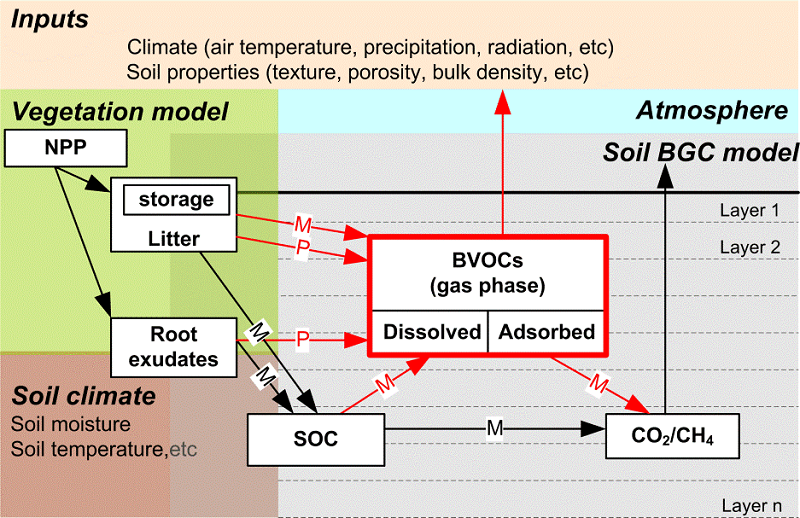Biogenic volatile organic compounds (BVOCs) are organic gases emitted by plants and microorganisms. Thousands of different compounds exist, and they are often very reactive in the atmosphere. A recent article in Reviews of Geophysics focused on the role of soil in both emitting and taking-up BVOCs. Here, the authors give an overview of soil BVOC dynamics and their impacts on the atmosphere, and describe a modeling approach for quantification.
How do plants and soils emit and consume biogenic volatile organic compounds?
Living plants are thought to be the main emitter of BVOCs from the biosphere. Plants emit BVOCs in conjunction with their growth and development, in stress defense, and through communication with other plants and insects.
Soil can both release and consume BVOCs. Bacteria and fungi in soils produce BVOCs through decomposition of plant litter and soil organic matter. Plant roots located in soil can also both produce and emit BVOCs. Meanwhile, soil can consume BVOCs from the atmosphere, through physically retaining compounds in soils and/or microbes taking up these compounds as carbon and an energy source.
The current global estimate of BVOCs emitted from plants is about 700 to 1000 teragrams of carbon per year, which is about twice the amount of methane emissions per year. However, the total amount of BVOCs emitted from soil—including from plant litter, roots and soil organic carbon—has not yet been estimated at the global scale.
How do BVOCs affect the Earth’s climate system?
BVOCs released from terrestrial ecosystems can influence local, regional and global climate. For example, the hydroxyl radical (OH) is an important atmospheric cleaning agent that can react with many pollutants and greenhouse gases. BVOCs can react with OH and thereby deplete it from the atmosphere. In turn, this can lengthen the lifetime of methane (a greenhouse gas) and hence lead to warming of the atmosphere.
BVOCs can also react with nitrogen oxides (NOX) and influence tropospheric ozone concentrations. Ozone in the troposphere is a greenhouse gas and air pollutant, and a threat to human health and the environment.
In addition, BVOCs and their reaction products can also be incorporated into aerosol particles (so-called biogenic secondary organic aerosol), which can reduce the amount of radiative energy received by the Earth and thus cools the atmosphere.
How do soil BVOC emissions vary over space and time?
Soil BVOCs vary with different plant species and soils types. For example, coniferous needle litter can release both compounds stored in the needle tissue and microbial-produced compounds during decomposition. In contrast, litter of broadleaved trees, even though without stored compounds, can be more easily broken down by microbes than needle litter, thereby producing BVOCs. In spring and autumn, when photosynthesis is limited by low temperature and light, soil BVOC emissions from relatively fresh litter can exceed plant emissions.
How can soil BVOC fluxes be modeled?
State-of-the-art ecosystem models take into account decomposition processes in soils in order to estimate fluxes of carbon dioxide and sometimes methane, but they do not simulate the production and consumption of BVOCs. In such models, vegetation variation, substrate amount (for example, the amount of litter and soil organic carbon), and soil environmental variables (in changes with climate inputs) are generally considered.
Adding soil BVOC-related processes into such models would require using existing data from multiple ecosystems to derive mathematical relationships to link the fluxes with considered environmental variables and substrate variability in models. Our review further suggests starting to model compounds that are often reported in the literature (See Table 1 in our review article), as these microbial-produced compounds might represent the wide distribution of related microbes in soils. There might be a need for considering physical properties of different compounds for modeling gas transfer rates out from soils.

One challenge is that modeling soil BVOCs is unlike modeling carbon dioxide and methane, as some of the compounds can originate from intermediate products of chemical reactions, not only as a direct product from microbial decomposition and/or plant metabolism.
Another issue is that the compound composition of emissions from soils could depend on the microbial community composition, yet linking soil BVOC fluxes with microbial diversity is challenging for ecosystem models at this stage.
Furthermore, in field observations, it is difficult to separate understory plant emissions from belowground emissions. The measurements with removal of understory vegetation and/or roots inevitably change soil structure and microbial community. Some compounds might not occur in natural, undisturbed environment. With these data in hand for building models, we surely face uncertainties in the estimated emission composition and magnitude.
There is still considerable work to do in order to model soil BVOC-related fluxes in a realistic way and further quantify their impacts on the atmosphere. Our review suggests a modeling framework and could initiate modeling attempts for quantifying soil emissions at different scales.
—Jing Tang (jing.tang@bio.ku.dk; ![]() 0000-0001-7961-8214), Guy Schurgers (
0000-0001-7961-8214), Guy Schurgers (![]() 0000-0002-2189-1995), and Riikka Rinnan (
0000-0002-2189-1995), and Riikka Rinnan (![]() 0000-0001-7222-700X) University of Copenhagen, Denmark
0000-0001-7222-700X) University of Copenhagen, Denmark
